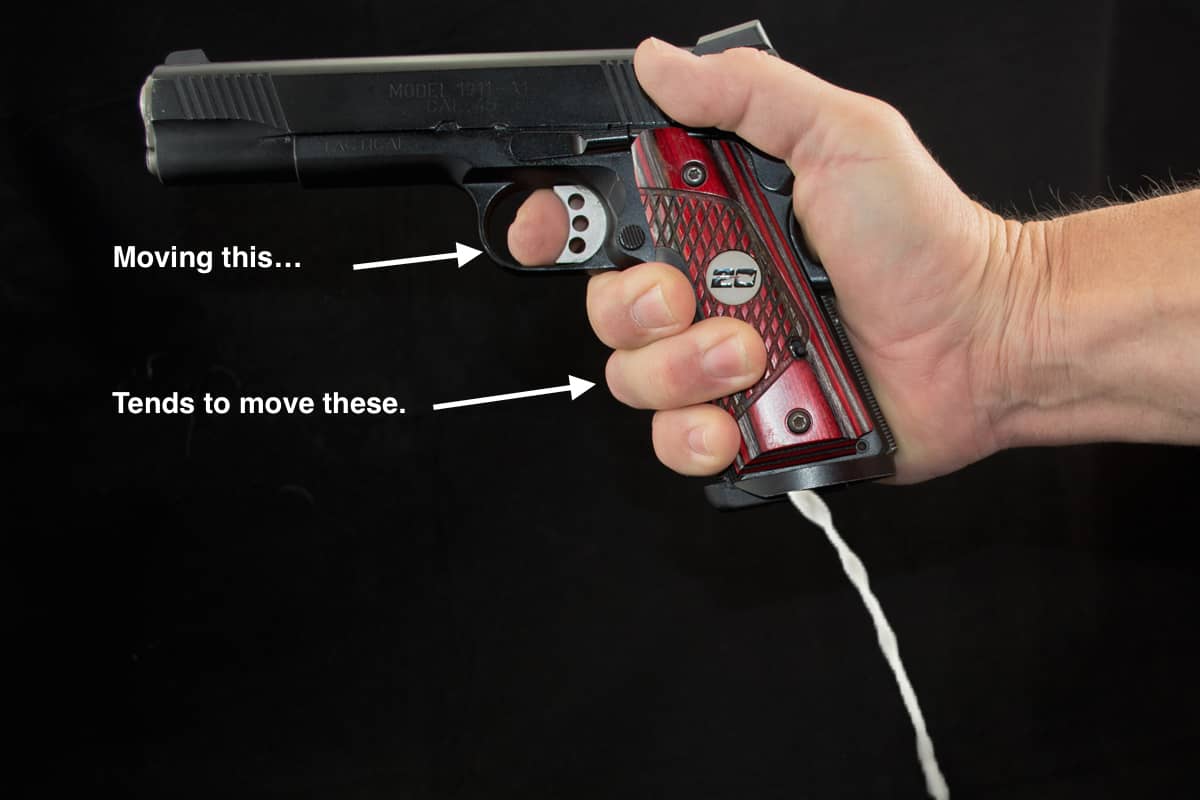Shooters: Are You Milking the Trigger?
Tom McHale 05.13.15

As I was born in the not-very-rural oceanside town of Corona Del Mar, I know less about milking cows than I do about birthing llamas. But I’m pretty sure that effective cow milking involves squeezing the udders with various degrees of pressure to get whole milk, butter, and cottage cheese direct from the factory, so to speak. I have no idea how to get chocolate out of there. If I ever tried to milk Ol’ Bessie, she’d have the 4-H Club protective services tactical squad battering down my barn door in no time.
Since the motion of milking a cow apparently involves squeezing some part of the bovine anatomy with your fingers, it’s not a far leap to figure out where the terms “milking the trigger” or “milking the gun” come from. In short, it simply means that your grip fingers are also contracting as your trigger finger contracts to press the trigger.
This sounds simple, but it’s really part of a much broader concept. The human body is full of sympathetic responses. Perhaps you’ve heard stories about people inadvertently firing their gun while doing something with their non-gun hand? When you grab or squeeze something with one hand, especially while under stress, your opposite hand naturally wants to mimic that movement. This is a real problem for police officers as they’re often corralling someone with one hand while holding a gun in the other.
In the case of milking, when you contract your trigger finger, the other fingers on the same hand want to contract, too. Try holding your hand in front of you in a natural resting position and curling your trigger finger in as if you were pressing a trigger. Odds are you’ll see movement in your middle finger, and decreasing degrees of movement in your ring and little fingers.
If this happens as you are firing a gun, the contraction of your grip-hand fingers will tend to move the gun muzzle in the direction of your palm and down. So, if you’re right-handed, the motion moves the gun down and to the left.
Stopping the leak
You know what they say, right? Admitting you have a problem is the first step toward recovery. It’s the same here. Sometimes, just the awareness that you are doing it is enough to help you develop better independent control of your trigger finger.
Another method advocated by lawman, competitive shooter, and instructor Massad Ayoob is what he calls the “crush” grip. While I don’t want to put words in his mouth, Ayoob’s focus is in self-defense and combat shooting, where adrenaline runs high, and the concern is getting accurate hits on target while under incredible stress. I suspect he would agree that his “crush” technique may not be ideal for leisurely bull’s-eye shooting, but it is an excellent solution for self-defense shooting.
Here’s the basic idea of how it works. Squeeze the living dickens out of your handgun until it starts to tremble. Got that? Good. You’re all set. The act of compressing your grip fingers as far as they will go essentially prevents them from contracting in sympathetic response as you draw your trigger finger backward. If the gun wobbles a bit from the strain, it’s no big deal as your accuracy will still be well within the limits of minute-of-bad-guy vital zones.
According to Ayoob, the technique has other defensive benefits, too. Your gun is your life in a defensive encounter, and if someone tries to grab it, you’ve already got a very firm hold of it. You can read his work directly to get deeper into the topic, but that’s the basic idea.
As with any technique, you’ve still got to experiment on your own. Want to try the crush grip? Go for it! Try a little more and a little less “crush” to find that works best for you. If the crush technique isn’t helping you, try reverting to the “hammer grip strength” technique and focusing on independent trigger finger movement.
Any deliberate effort to remove milking symptoms is best addressed with lots and lots of dry fire practice. Rather than discuss dry fire practice here, I’ll point you to this article on “going through the motions.”
I’m a big fan of lasers, and one of the reasons I like them is that they are a great training aid. Seeing minute movements of your front sight during dry fire is possible, but difficult. Seeing the impact of slight gun movement by watching a laser dot dance on the opposite side of the room is enlightening. Pick a safe backdrop target 20 or 30 feet away and turn on your laser while you dry fire. If you can keep that laser dot within a two-inch circle, you’re doing great.
There are a number of other reasons that your shots may not be impacting where you want, so milking is just one possibility. Misses could be the result of recoil anticipation or simply a jerky movement of your trigger-press motion. But if your shots are grouping off to the side, try the laser dry-fire technique or have a buddy watch your shooting for signs of milking.
Tom McHale is the author of the Insanely Practical Guides book series that guides new and experienced shooters alike in a fun, approachable, and practical way. His books are available in print and eBook format on Amazon.

